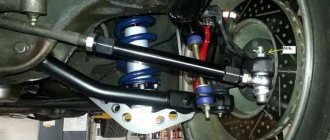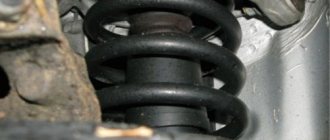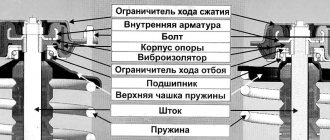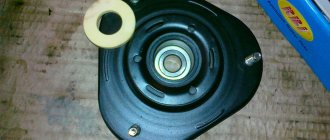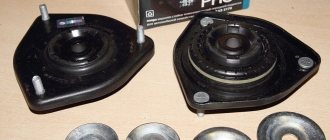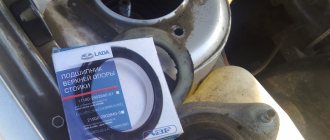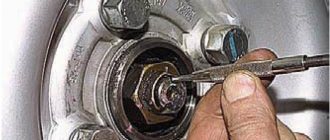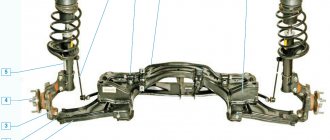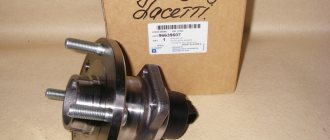If parts in the front suspension of a car malfunction, various squeaks, knocks, clicks and rattles occur while driving. It is clear that this is not just like that. The suspension desperately signals that a diagnosis needs to be carried out, and the sooner the better.
There are not so many parts in the front suspension that even a simple external inspection cannot detect a malfunction. To do this, it is not necessary to have extensive experience in suspension repair. It is important to be careful here, and most importantly, you need to know the structure of the car well and understand what functions the components and parts of the car perform.
Front suspension
Consider the front suspension of a passenger car. Despite the design features of different types of models, all front suspensions are fundamentally the same. True, not all parts can be part of the suspension.
Since the car has two front wheels, many parts can be paired. Here is an approximate list of what is included in the front suspension:
- Steering knuckles (or axles), right and left;
- Front shock absorbers, right and left (can be symmetrical);
- Front springs (mostly symmetrical, but available right and left on some models);
- Front stabilizer, there is only one;
- Stabilizer struts, there are two of them, are rarely asymmetrical;
- The front suspension arms are almost never symmetrical, but they can be upper and lower, and there is also a multi-link suspension;
- Support bearings are always symmetrical, two bearings, but not available on all models;
- Support cups, boots, spacers, etc.
Support bearing
So, support bearings are not available on all models. Their presence is required where the shock absorber itself or the shock absorber strut rotates together with the steering knuckle. The bearing allows the shock absorber to rotate freely in its upper support, without resistance or unnecessary friction.
The support bearing (OP) is located above the front spring, and the shock absorber rod passes through it. Depending on the design features, it can be prefabricated or a single part, but one way or another, the shock absorber is attached to the front side member of the body.
At its core, the part is a rolling bearing; it has a wide cage. The OP must be durable, as it experiences heavy loads when the front spring operates, especially on rough roads.
Support bearing faults
What are the signs of a faulty support bearing:
- when the car is moving, a knocking sound is heard in the area of the right or left front side member of the body, it is especially noticeable when turning and on uneven roads;
- The car has become less controllable and does not immediately respond to turning the steering wheel.
For what reasons can the front bearing fail:
- Poor road conditions;
- Very harsh driving style;
- Factory defects, low quality parts;
- Natural wear of bearings during long-term operation.
It should be noted that support bearings cannot be repaired; a faulty bearing must only be replaced. There can be no talk of any repairs. But the details can be prevented. You can remove the protective cover from the bearing race and treat the inside of the race with lithium grease. Of course, such an operation must be carried out on a working OP.
Volkswagen Polo Sedan - Replacing shock absorbers
In general, I came to the service center to change the shock absorbers (as I was told, the rear ones were dead)
To avoid unnecessary questions, I’ll say right away: Kayaba 339763 Front gas shock absorber “Excel-G” Kayaba 344357 Rear gas shock absorber
Everyone was very interested in telling me which shock absorbers I bought to steal my car, because there are very different opinions and reviews about these Japanese parts. My review is below.
The wheels were removed and the rear shock absorbers were removed very quickly and easily. The old ones were completely killed, when I asked how it turned out (that they were killed), I was shown how they firmly remained in the same position when they were crushed and crushed. Did you understand))
After some manipulations by the craftsmen, the rack was assembled.
What I really liked: before putting the wheel in place, the drums were treated with copper grease so that nothing would stick.
In addition, if you knew about copper grease, there is a gel (I was told that this is a proprietary gel, but this is not entirely true)))) that treats the bolts.
A torque wrench for me is always an indicator of quality of service: all bolts need to be tightened as needed, and not by accident))
How to determine if a support bearing is faulty
It is very simple to determine the malfunction of the OP. You need to open the hood, grab the shock absorber strut with your hand where it is attached to the body and swing it sharply from side to side. If there is play in the bearing or it has crumbled, the strut will move with characteristic clicks. You can do the opposite - grab the wing and rock the car sideways. Then, if the OP is faulty, the body will move, but the stand will remain almost motionless. All movements must be accompanied by knocking in the area of the defect.
Replacing the support bearing
To replace the OP you will need a jack, automotive tools and spring ties. Disassembly order:
- Loosen the wheel nuts.
- We put a jack and lift the car with a jack (you need to be on the safe side - put jack stands under the rear wheel)
- We remove the wheel.
- We disconnect the brake caliper and move it to the side; there is no need to disconnect the brake hose.
- We release the steering knuckle from the bottom from the lever and stabilizer bar.
- We unscrew the fastening of the shock absorber strut to the side member from above and remove the shock absorber with the spring and steering knuckle - the entire structure is assembled.
- We tighten the springs with zip ties and disassemble the shock absorber strut.
- We change the support bearing and reassemble everything in the reverse order.
There is one clever way in which zip ties are not required to replace the OP. While the wheel is not removed, you must first disconnect the nut securing the shock absorber rod. But to replace with a similar method, it would not hurt to have a little experience in repairing the chassis of cars.
In general, the job of replacing a thrust bearing is not very difficult; only normal hands and tools are required.
To avoid serious damage to car systems, you should pay attention to the slightest knock or creaking noise under the hood. If you stubbornly ignore seemingly minor signs of malfunction, then serious problems cannot be avoided. In particular, this is a knocking sound when turning the steering wheel. It may indicate a faulty front strut upper support bearing. Changing the support itself is quite simple, and this process will not be accompanied by serious costs. But if you do not pay attention to the breakdown in time, it will lead to more serious consequences.
Device
Let's first analyze its device.
Here is a picture of a thrust bearing. In its upper part there are three studs for its fastening and one central fastening through the inside of the support.
This video was created to explain the essence of installing a support bearing, the purpose of which for some reason most car enthusiasts forget. They only know the purpose of shock absorbers and springs, although the support is an equally important element in the car’s suspension.
Video
Struct assembly diagram for Kalina car
Scheme for assembling struts for Granta vehicles
The video above (see pictures) shows:
• Attaching the upper part of the rack to the body mudguard;
• The stand itself is disassembled with a spring and upper support;
• Support bearing (there are several types).
The upper support serves to smooth out the loads coming from the wheels through the shock absorber onto the car body and distribute them evenly.
Support bearing wear
As it is used, the support bearing wears out and there is grinding, creaking, knocking, and the most dangerous thing is when play appears. All this is reflected in the condition of the rack itself and the entire wheel assembly.
So, if you lift the car on a lift and move the wheel sideways, right/left, you will notice a large free play of the entire assembly, which will tell us that the support bearing requires replacement.
If you look from above, where the shock absorber rod is attached, you will notice its movement from side to side. You can also place your hand on the top of the shock absorber where the rod nut is located. In this place the play is clearly felt.
When the bearing balls wear out, the load on the front suspension elements increases and the vehicle's handling deteriorates. Consequently, all this negatively affects overall traffic safety.
Replacing the rack support
To replace the support bearing, the strut must be removed from the car, disassembled, after compressing the spring with special ties. The faulty support is removed, a new one is installed, the rod fastening nut is tightened, the ties are removed and the stand is installed on the car.
After replacing the supports, it is recommended to check the wheel alignment on a stand to check the wheel alignment angles.
That's all, write comments. Goodbye!
In this article we will get acquainted with a small but very important component of a car's suspension - this is the front strut support bearing (in common parlance, a support bearing).
Let's try to find out why it is needed, what threatens it, and how to determine that a part requires replacement.
There is not a single unnecessary part in the machine, so if at least one of them fails, this can pose a threat to its overall performance. As a rule, a harbinger of malfunctions can be:
- changes in vehicle behavior;
- the appearance of extraneous sounds and knocks;
- unusual vibrations.
Function of front strut support bearings
As the name suggests, the part performs a supporting function. It is the connecting element between the front hydraulic shock absorber strut and the vehicle body. This is a version of a rolling bearing. The part is subject to significant axial loads, which is why it is made of high-strength alloys. And under the road conditions in which modern cars have to travel, the part wears out much faster than we would like. Therefore, it should be checked every 20 thousand km. mileage The worse the quality of the roads you drive on, the more often you need to check it.
To make it clearer where exactly the part is located and what function it performs, you need to remember how the front suspension of the car is designed. For example, let's take a VAZ-2110 car. It has an independent suspension with hydraulic struts. Most modern cars are equipped with the same. The design of the front strut effectively dampens vibrations that occur when the shock absorber spring moves.
Here, special attention should be paid to securing the rack itself. At the bottom it connects to the rotary cam. And at the top – directly with the body. The movable mount is provided by the front strut bearing.
